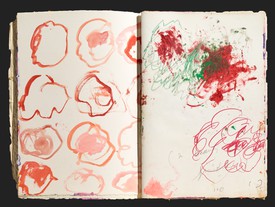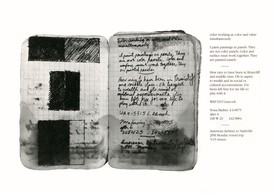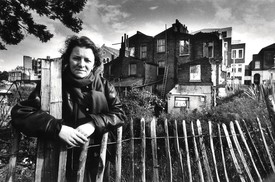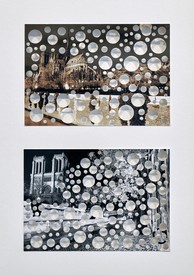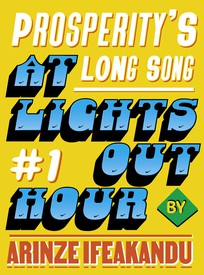
Patti Smith is a writer, performer, and visual artist. Her memoir Just Kids received a National Book Award, and her recent book M Train is a critically acclaimed New York Times best seller. Smith was awarded the prestigious title of Commandeur des Arts et des Lettres by the French Republic. Her seminal album Horses has been hailed as one of the top one hundred albums of all time, and in 2007 she was inducted into the Rock and Roll Hall of Fame. Smith lives in New York City. Photo: Edward Mapplethorpe
Last spring was for me the season of Simone Weil. I read two biographies while simultaneously reading her work, beginning with Gravity and Grace. Simone Weil was a French visionary and activist. During World War II, owing to her Jewish heritage, she was unable to stay in Paris or join the French resistance movement and was obliged to contribute to the war effort in England. Suffering consumption, she was forced to enter a sanitarium in Ashford, some sixty miles from London. It was there that she died, never seeing her mother’s face or her beloved France again, and was buried in the cemetery not far from the train station. I could not help but feel sadness that her body could not be returned to her own country. I read the account of her death while in Southern France. That afternoon I found a patch of lavender. I thought of her in her patient’s bed, with no hope of recovery or return to her homeland. I imagined how much a small bouquet, with its intoxicating fragrance, would have meant to her at that moment. Small things with incalculable worth.
Impulsively I wrapped some of the lavender in a handkerchief and decided to find her grave and place a bit of France where she was buried. Visiting the resting places of people I never knew, but whose work has guided or inspired me, is one of my missions while traveling. I travel a lot, for work, literary conferences, exhibitions, and touring with my band. Not being very social, I find myself drawn to obscure cafés and cemeteries. The café to think; the cemetery to thank. In this manner I was able to thank Hermann Hesse for writing The Glass Bead Game. Sylvia Plath for her poems. Genet for The Thief’s Journal. Dag Hammarskjöld for his quest for peace. Often, after simple meditation, I take a photograph, as a remembrance, as a relic.
And so, armed with a bundle of lavender, I left France, taking a train to London. At St. Pancras International I boarded another train to Ashford, to find Simone Weil’s grave. As we passed endless row houses and a somewhat lifeless landscape, I noticed the date on my ticket, June 15, the birthday of my late brother Todd. His only child is a daughter named Simone. I immediately brightened. Only good could happen on such an auspicious day.
Arriving, I found a coffee stand, then looked for a taxi. The sky was deepening and there was a strong chill in the air. I removed my camera and watch cap from my suitcase. The taxi ride took about fifteen minutes and I was dropped off in front of the entrance of the Bybrook Cemetery. I half expected there would be a little stone carriage house or someone distributing maps, but there was no one—only a groundskeeper cutting weeds in a veil of light but steady rain.
The cemetery was more sprawling than I anticipated and I had no idea where Simone’s resting place might be. I walked up and down paths, somewhat daunted. The light was low. Only noon, yet more like sundown. I took a few photographs. An embedded cross. An ivy-encrusted tomb. Nearly an hour passed. It continued to rain. A part of me was succumbing to the notion that it was an impossible task when I suddenly remembered that she was buried in the Catholic sector. I found an area with many likenesses of Mary, and crosses everywhere, but no trace of Simone. The sky grew darker. I sat on a bench, somewhat demoralized. Would Simone approve of this pilgrimage? I thought not. But I had lavender in an old handkerchief to leave her, small bits of France, and recalling her love of her homeland, her longing to return, I pressed on.
I looked up at the menacing clouds.
I entreated my brother—
Todd, can you help me? I’m alone on your birthday and searching for someone named Simone.
I felt his hand guiding me. On my right was a wooded area and I felt compelled to walk toward it. Suddenly I stopped. I could smell the earth. There were larks and sparrows, a small shaft of light that appeared, then disappeared. I turned my head with no exalted pause and found her, in all her modest grace. I opened the bellows of my camera, adjusted my lens, and took three Polaroids. I slipped them in my pocket and did not look at them. As I knelt to place the small bundle beneath her name, words formed, the gestation of a poem or prayer, tumbling like a nursery song. I felt helplessly at peace. The rain dissipated. My shoes were muddied. There was an absence of light, but not of love.
Artwork and Text © Patti Smith. This text is an expanded chapter from Smith’s Devotion published in September 2017 by Yale University Press.

